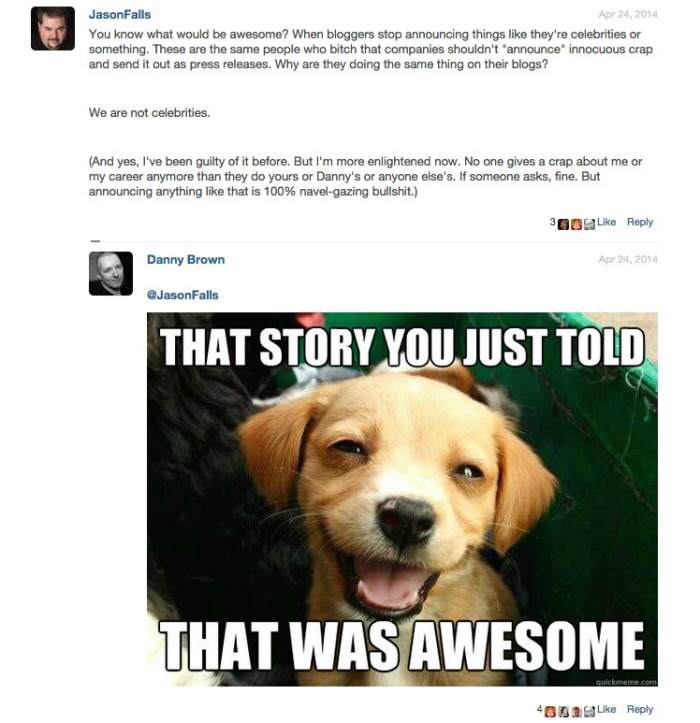GUYSIDE: The king is dead, long live the king!
 This is a bit of a valedictory for Guyside. After 54 happy posts here on FlashFree, we’re at the end of the road. Asking guys to contribute to a site about menopause was a bit of a courageous and audacious move, which fits this blog’s major-domo Liz Scherer quite well.
This is a bit of a valedictory for Guyside. After 54 happy posts here on FlashFree, we’re at the end of the road. Asking guys to contribute to a site about menopause was a bit of a courageous and audacious move, which fits this blog’s major-domo Liz Scherer quite well.
And as the writer of most of these posts, I am glad she asked me, and addicted enough to doing this that I’ll be continuing the Guyside tradition on another site, while the archives will always be available here, with my posts, as well as the other Guyside contributors Danny Brown and Rich Becker.
Want to know more?
Listen to this Skype conversation between Liz and I. Happy and Healthy New Year, and stay tuned for more!
Image: CC-licenced by Flickr user Mark Ramsay
Read MoreGUYSIDE: Keep a weather eye out for dubious claims.

Take a hint from Pepe, and be skeptical of medical claims — the more grandiose the more skeptical!
I was watching my local newscast recently and heard about an innovative new treatment for “winter blues”, or Seasonal Affective Disorder. As someone who strongly dislikes 4 pm sunsets, I was interested enough to keep watching.
The treatment is a device called the Alpha LED Light Spa. This device, which resembles a tanning bed, offers a variety of programs that combine light, heat, and oxygen to treat a variety of symptoms. The owner of this particular device told the reporter that it was an effective treatment for more than 1000 disorders — and that REALLY got me interested. Here’s the list:
“Energizing Whole Body, Mind and Spirit, Cold/Flu, Sleep/Insomnia Improvements, Depression, Seasonal Affective Disorder, Mind Clarity, Meditation, Pain Relief, Lymphatic drainage, Wound Healing , Immune Boost, Stress Relief, Detoxification, Weight Loss, Cellulite Treatments, Skin Care – Acne Treatments, Skin Care – Anti-Aging, Addictions, Balances hormones, Migraine relief, Soothes nervous system, Lowers cholesterol, Infertility, Psoriasis, Anxiety, Inflammation, & more.”
Unfortunately, there’s no links to evidence on the site. And I haven’t been able to discover any in my time looking around. There is little doubt that SAD, disruptions in sleep due to circadian rhythms, and depression can be treated effectively by light therapy. But on the face of things, it seems unlikely that this device would be able to successfully treat more than 1000 problems.
Claims like this need to be taken skeptically, not least because at the Ottawa spa offering these treatments, it’s $75 per session.
And there’s no shortage of claims that need to be given the side-eye. Also this week, an article in the British Medical Journal looked at medical recommendations made on the Dr. Oz show and The Doctors. In the case of Dr. Oz, fewer than half of the medical recommendations provided had any sort of supporting evidence backing them up; 1 in 6 were actually contradicted by medical evidence.
It’s easy to make a medical claim, and ones that fit into what we want to hear (eat this and your belly will magically shrink!) are much more readily consumed by us humans than ones that are a little more work (eat less, move more, and stop with the Big Gulps).
You owe it to yourself to ensure the actions you take to preserve and improve your health are ones that have a basis in fact.
For those who’ve just finished celebrating Chanukah, and for those who are anticipating a visit from Santa, Merry Christmas and Happy Holidays!
(Photo is CC-licenced from Flickr user Yiie)
Read MoreGuyside: The Beautiful Freedom of Not Giving a Crap
When I was much younger – say, around 8-9 years old – I used to get in trouble with my school teachers, and other adults in positions of authority, regularly. Pretty much not a day would go by without my mother receiving some troublesome news about me.
I guess, looking back, I simply had an aversion to authority.
And while that continued until my early teens, when I learned what it meant to really show respect and understand conflict with authority was primarily in my mind, I also learned something at that young age that must have made an impression (even subconsciously) from my granddad.
Wisdom Has No Age Limits
I always loved my granddad. He was the safety net I’d cling to when everyone else seemed down on me. He was the one that would let me watch TV just that little bit later. He was the one who would let me read my comic under the bed with the flashlight, when everyone else would confiscate the flashlight.
In short, he was the one that would break the rules and let me be who I wanted to be. Except, not really.
Instead of letting me be an out of control tearaway, looking back he was actually guiding me to be a better person because of the trust I had in him. When he spoke, I’d agree and nod – even if I didn’t like it. And – usually – do as he said.
Whether or not my mother was in cahoots with him in this endeavour, I’ll never know. Perhaps, perhaps not. Either way, he made me stop and think of the things my mother was trying to teach me.
So, when I was having my brush with people in authority, my granddad pulled me aside, and said the following:
You might think grown-ups are bad, and stopping you from having fun. And, sometimes, they will. But it’s only because they love you. Now – you can choose which ones to listen to. And, I know not everyone is worth listening to. So here’s a trick – listen to the people who love you, every time. Your mum. Your sister. Me. Your grandma. Listen to your friends, but only the ones who don’t make you feel bad about yourself. And listen to your teachers who make you smile when you’ve done something. These people are all just trying to help you enjoy life. And that’s something not everyone will do.
Now, I know I’ve paraphrased some of his words. After all, this was almost 40 years ago (holy crap, I’m getting old!!). But the gist of the message is definitely there.
And it’s one I use today in pretty much everything I do, and you should too. Here’s why.
Living Life The Way It’s Meant to Be Lived
In a recent edition of TIME, there was a fantastic memorial article by David Von Drehle, about a gentleman named Charlie White. David and Charlie were neighbours, and David’s piece wrote about the lessons Charlie instilled from a life well lived. Charlie was 109 when he passed last month.
The article recounts passages of time from the turn of last century, and is a fascinating and warm look into a period of time most of us will never have known. Yet it’s also a reminder of how to live a life well lived.
Charlie’s “secret” to a happy life was the realization that you have to separate the things you can’t control from the things you can. This was a lesson he imparted to one of his daughters when she was having issues with someone that was frustrating her. Charlie’s advice?
You can’t change people like that. If I let people irritate me, I would have been dead long ago. Source.
The fact Charlie lived such a long and happy life has to have some part in this mindset. It’s the same mindset my granddad had, and is – essentially – the one I try to live to these days.
After all, let’s face it – how important are the words of others who actually have no real impact over who we are and what we stand for?
Those That Matter and Those That Meh
Back in April of this year, I wrote a post on why readers of this blog might want to unsubscribe. It was a post that shared the direction this blog was moving in, and a heads up that if readers wanted to subscribe to a purely marketing blog, this one wouldn’t be for them (and I recommended five other blogs to subscribe to instead).
I’d just become bored of only writing about marketing, social media, etc., and all that entails. We’re people, all of us – we’re not tied to talking about just business in life, so why should we be on our blogs (or other social footprints)?
After this post, I received a whole bunch of emails (as well as comments on the post itself) from others who felt the same, and were “glad” to see someone say it out loud, encouraging them do the same thing. And that’s the real beauty of blogging and content – even if you help just one person make a choice, that’s all that matters.
Arik Hanson, a PR and communications pro over in Minneapolis, shared his thoughts in a post entitled “Is the age of the independent PR blogger over?”. He looked at how many of the bloggers in his feed had either changed direction, or simply given up altogether to concentrate on, well, life and family and all that important stuff.
In the comments, social media guy Jason Falls left quite the entertaining diatribe (click image to expand).
When I got the update to the comment being left, it made me chuckle – because, really, who gives a crap?
It doesn’t matter what Jason thought (and I like Jason, he seems a decent guy), because it wasn’t for him (hence the dog picture reply). The original post was for the folks who said it helped them make up their minds to produce the content they really wanted to produce.
And that’s why we need to collectively take more of a “who gives a crap?” approach to comments, blog posts, social updates, etc. The people that moan and react usually aren’t the ones that either matter (from an audience point of view), or who have little relevance to you anyway.
If someone on Google+ calls you an idiot for having a point of view, who cares? The real idiocy comes from trying to stifle opinions with rudeness or ignorance. If that person has little effect on your bigger picture, let them stew in their own little miserable bubble.
Same goes for the content you produce. Own it, and be happy to own it.
Enough With the Egg Shells
There was a great post earlier this year from Marc Ensign, called “The Pussification of the Internet”. In it, Marc shares how the web has become this place where we’re too scared to have an opinion, because we’ll be jumped on by others, or called to task, etc.
Because of this, the web is in danger of becoming a sanitized version of what it should be – open, challenging, questioning and, most of all, bare bones honest. It’s a great – if not quite safe for work read – and well worth your time,. Because it’s true.
Last month, the Pew Research Internet Project released its latest report, and it made for some enlightening – and a little bit scary/sad – reading.
Entitled “Social Media and the Spiral of Silence”, it shared the answers of just over 1,800 adults and their thoughts on the impact of the Edward Snowden / NSA fallout in the US and beyond, and how that affected the way these adults conversed online.
There are many interesting takeaways from the report, but two in particular stood out.
- In both personal settings and online settings, people were more willing to share their views if they thought their audience agreed with them. For instance, at work, those who felt their coworkers agreed with their opinion were about three times more likely to say they would join a workplace conversation about the Snowden-NSA situation.
- Previous ‘spiral of silence’ findings as to people’s willingness to speak up in various settings also apply to social media users. Those who use Facebook were more willing to share their views if they thought their followers agreed with them. If a person felt that people in their Facebook network agreed with their opinion about the Snowden-NSA issue, they were about twice as likely to join a discussion on Facebook about this issue.
Now while these two points refer to unease on how the US government is monitoring the conversations of its citizens, it also highlights the growing issue of just going with the flow as opposed to taking a stand.
It’s a walking-on-egg-shells mentality that both limits our growth and inhibits our learning. If we were all meant to have the same point of view, we may as well quit now because there would be no need for us to be.
That’s not to say we ignore everyone else – far from it. But we do need to start standing up for ourselves and our opinions more, and not just be part of the herd.
Like my granddad said himself, think of who you want to listen to. Think of who you want to take advice from. Think of who actually matters, and whose opinion and feelings you wouldn’t want to hurt. And be respectful of those you disagree with.
For everything else – who gives a crap?
This post originally appeared on dannybrown.me.
Read MoreGuyside: Girls deserve more than one way to wear a bow.
With the abundance of bow savvy heroines making a mark on the silver screen, it wasn’t any surprise for me to see my daughter don a hood and fill a quiver for Halloween. What was a surprise, however, was how almost every neighbor narrowed their errant guesses to the confines of gender.
“Who are you … Katniss?”
“No.”
“Merida?”
“No.”
“Tauriel from the Hobbit or Susan from the The Chronicles Of Narnia?”
“No and no,” she said. “I’m Robin Hood.”
She said it with enough conviction to corral the conversation. She was Robin Hood and the only person who questioned her about being a girl was a 5-year-old boy. Once she reassured him that a girl could be Robin Hood, he turned his attention to her bow and arrows. Next year, he said in wide-eyed wonder, he would be Robin Hood.
Next year, she said, she would like to be a princess like she was two years ago too. The only bow she sported back then was a yellow one to tie her hair back. But the year before that she was a pirate. And the year before that, she was a wood fairy in the vein of Tinkerbell. There are no limits to her imagination, especially those related to gender.
It’s part of a trait I hope she retains all her adult life too — the art of being gender ambidextrous, whereby every decision she makes is made based on passion and aptitude over the societal shakedowns over being feminine and a feminist. Life is complicated enough without trying to conform to a stereotype or work even harder to avoid one.
It seems to me that there is something inherently wrong when our daughters think that they have to ask permission whether or not they can dress up like Han Solo for Halloween. And while the girl who asked was very fortunate to have Tom Burns (who dressed up as Princess Leia) as a dad, it still haunts me that any 7-year-old girl would be so cognizant of gender-flipping costumes.
It’s almost worrisome as the growing number of parents who think the princess syndrome needs to be cured in seconds. It doesn’t.
Kids aren’t really part of the good role model/bad role model debate unless they are indoctrinated by the people who invented it. Sure, some stories might carry moral messages but none of the princesses really auditioned for the role model moniker (and neither did their princely counterparts, who suffer all sorts of severe character flaws).
The far greater danger is to perpetuate the myth that feminine and feminism have to somehow exist as polar opposites. They don’t. If the operative word is choice, then let girls make their own.
My daughter feels equally comfortable in a sundress or her fast-pitch softball uniform, which is usually covered in dirt five minutes before the warmups are over. She has an appreciation for art and music as much as for engineering and science. She is just as likely to play with Hot Wheels as Barbies, but is no more inclined to wish for wheels instead of feet than she is for that impossible waistline. She enjoys dodgeball as much as Girl Scouts and, on any given day, can show off a pirouette or hold a plank position.
It’s a freedom that I hope she preserves all her life, not as someone who is gender ambiguous but rather gender ambidextrous. Women should never feel forced to give up a stitch of gender identity to achieve equality. On the contrary, it will be my daughter’s ability to embrace her gender without being made a slave to it that will eventually empower her generation to move beyond the idiocy exhibited at companies like Zillow or Uber.
Robin Hood, after all, didn’t ask the poor to fix the inequality of his era. He wanted the rich to change their behavior.
Read MoreGUYSIDE: salty talk about your diet
 I’ve been keeping an eye on my blood pressure these days. With a family history of hypertension, it just makes sense. And so far, my results are good. A while ago, I stopped at a local pharmacy and used their automated machine and saw a couple of readings heading into the high range. But more accurate readings have put it further down in the normal range, so that’s good.
I’ve been keeping an eye on my blood pressure these days. With a family history of hypertension, it just makes sense. And so far, my results are good. A while ago, I stopped at a local pharmacy and used their automated machine and saw a couple of readings heading into the high range. But more accurate readings have put it further down in the normal range, so that’s good.
But when I looked at my profile for hypertension risk factors, I was struck that there wasn’t a great deal I could do. The major risk factors for hypertension, according to the Mayo Clinic, are:
- Age. (Hypertension is more common in men around 45 or so, and becomes more common in women around 65)
- Race. (High blood pressure is particularly common among blacks)
- Family history.
- Being overweight or obese.
- Not being physically active.
- Using tobacco.
- Too much salt (sodium) in your diet.
- Too little potassium in your diet.
- Too little vitamin D in your diet.
- Drinking too much alcohol.
- Stress.
I do pretty well on most of these. But of the ones I can control, the one about sodium sticks out. As a man and a lover of food that I KNOW is bad for me, I know that I can be the author of my own hypertensive misfortune. Burgers, fries, onion rings, chicken wings — it would be foolish to pretend they don’t have a lot of sodium in there. But there are a ton of foods out there that you wouldn’t expect to have high sodium levels.
We often have pizzas on naan bread for a quick and easy weekday meal. On top, prosciutto, pears, brie, and basil. I knew the prosciutto would be high in sodium — after all, it’s a cured meat. But the naan bread itself has a surprising amount of sodium. Between those two ingredients, one naan pizza is likely delivering more than half my daily allowance of sodium.
Chicken breasts can be injected with brine during processing, increasing their sodium content drastically. A slice of process cheese might have 20% of your daily allowance of sodium!
If you have french fries, you expect them to be salty. But if you add a tablespoon or two of ketchup, you’re looking at 400 mg of sodium just in that!
And none of this counts restaurant or takeout food, which can be extremely high in sodium. You can see just how easy it would be to end up with more than your roughly 2,500 mg of sodium per day:
- 350 mg: a bowl of Raisin Bran.
- 870 mg: a bagel and cream cheese
- 1220 mg breakfast
- 1600 mg: 100 grams of deli ham on white bread with mustard.
- 1600 mg lunch
- 393 mg: baked chicken breast
- 418 mg: baked potato
- 460 mg: cup of canned peas
- 1271 mg supper
- 744 mg: 1/2 cup of salsa
- 420 mg: 24 tortilla chips
- 1164 mg snack
That’s a whopping 5255 mg of sodium, more than twice the recommended amount in a day, without a single shake of your salt shaker, without eating out, and with lots of things that seem healthy at first glance. (Sodium figures from the Fat Secret website)
You can’t change your age, your race, or your family history of hypertension. But if you start to track things like sodium, you do see where you can help prevent hypertension, or if you have it, improve it without resorting to drugs. And that’s a good thing.
(Pretzel photo is a CC-licenced image from Flickr user Jenn Durfey)
Read More








